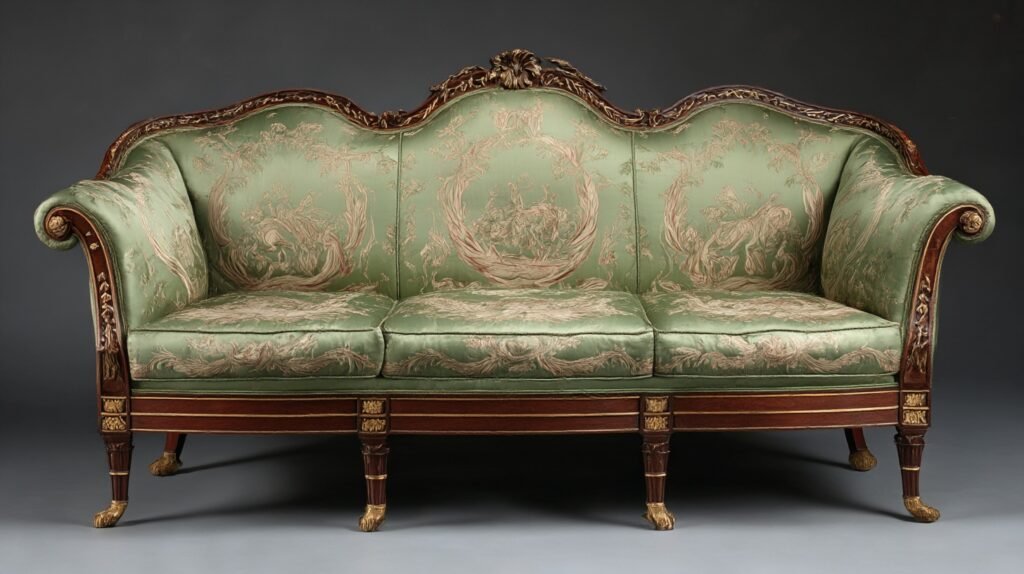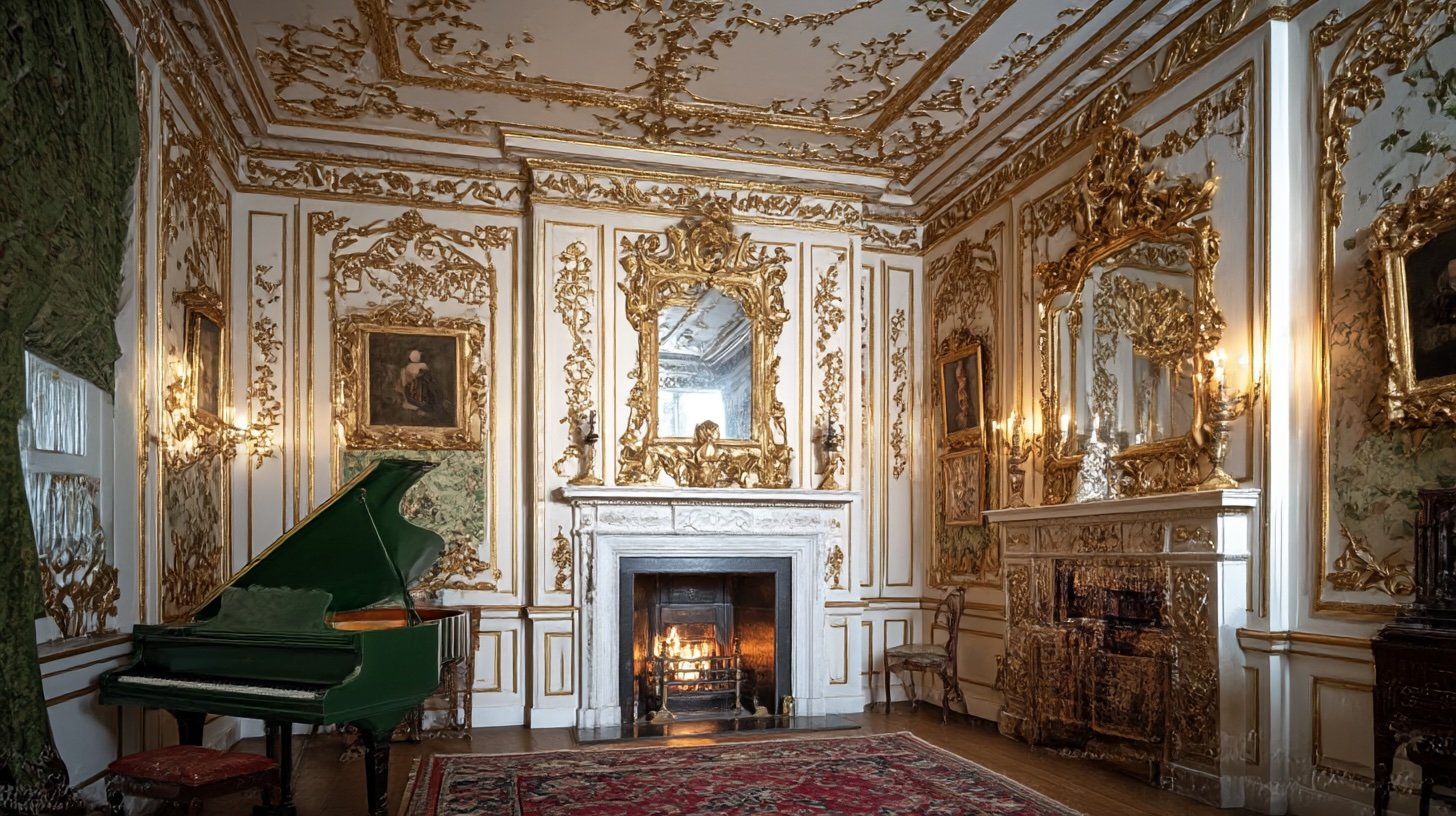The Powdered Whimsy of the British Rococo
You could say the British Rococo era was the eighteenth-century version of wearing an embroidered waistcoat to a garden party and then tripping over a marble cupid. Originating as a sort of continental fashion import, the British Rococo era never quite took itself too seriously, which was part of its charm. It sparkled, swooped, curled, and flirted its way through the middle of the Georgian period, all while being subtly mocked by the British themselves. Rococo, with its soft curves, pastel colours, and love for anything vaguely resembling a seashell, landed in Britain like a powdered wig in a wind tunnel—highly decorative, slightly absurd, and far too French for comfort.
Unlike their Baroque predecessors who seemed obsessed with grandeur and God, Rococo artists and decorators just wanted everyone to lighten up. The style waltzed out of France after Louis XIV finally stopped micromanaging Versailles, and the French decided they were tired of golden thrones and eternal judgement. Over in Britain, Rococo arrived with a whiff of scandal and lavender-scented wallpaper. Architects, painters, cabinetmakers, and decorators fell for its cheerful ornamentation, but British restraint insisted it all be kept just a touch more modest.
Take Thomas Chippendale, for example. Here was a man who could make a chair look like it was flirting with you. Chippendale furniture during the British Rococo era was flamboyant yet practical. He wrote a book—because of course he did—called The Gentleman and Cabinet-Maker’s Director, a sort of eighteenth-century IKEA catalogue for the wealthy, full of fantastical designs featuring ribbons, scrolls, acanthus leaves, and occasionally, a dragon.
Then there was the ceiling game. If you didn’t have at least three putti dancing across your plasterwork, were you even trying? Thanks to stuccowork geniuses like Joseph Rose and Robert Adam, British ceilings turned into full-blown fresco fiestas. You’d be nibbling on a syllabub at a salon and look up to find cherubs having a toga party above your head.
And let’s not forget rocaille—a term so French it practically wears perfume. The British never fully warmed to the seashell-on-seashell aesthetic that rocaille represented in France. So they adapted it, translated it, and gave it a bit of architectural stiff upper lip. Gilded mirror frames curled like waves, but were often paired with stately columns or sombre fireplaces, because one mustn’t go entirely mad with frivolity.
The British Rococo era was like a rococo painting of a picnic—until you realise it’s raining, the cows have wandered into the wine, and someone has set fire to their wig. Despite its lighter tone, the Rococo era often satirised itself. Think William Hogarth. His prints were the eighteenth-century equivalent of a meme thread roasting Rococo pretensions.

He gave us The Rake’s Progress, where young Tom squanders his inheritance on women, wigs, and wall hangings, eventually ending up in Bedlam. The backgrounds of Hogarth’s works are full of elaborate furnishings, absurd fashion, and impractical decor—all nods to the Rococo’s obsession with artifice.
Tea drinking became a national obsession in this period, and the objects associated with tea service got a Rococo makeover. Teapots started looking like porcelain clouds. Cups and saucers shimmered with gold accents and allegorical nonsense. Even sugar tongs got the rococo treatment. The British took tea, a rather serious social activity, and laced it with an absurd amount of curlicues.
Porcelain was big. Bow, Chelsea, and Worcester potteries all jumped on the Rococo bandwagon, churning out soft-paste porcelain figurines of shepherdesses, musicians, and various frolicking nobility. These knick-knacks filled mantelpieces across the country, smiling serenely despite having no purpose beyond catching dust and impressing the vicar.
Wallpaper also got caught in the Rococo net. The British imported Chinese hand-painted wallpapers and married them off to domestic Rococo flair. Picture birds, butterflies, branches—an entire forest scene trapped behind a drawing room wall, coexisting with European cherubs and gold leaf.
The gardens went Rococo too. Landscape architects like William Kent tossed out the rigid symmetry of earlier formal gardens in favour of meandering paths, grottos, and faux ruins. Yes, fake ruins. Nothing said refinement like a crumbling column strategically placed beside an ornamental lake. Because obviously.
Furniture in the British Rococo era didn’t just serve a function—it posed. Console tables grew cabriole legs, mirrors wore elaborate wigs of gilded wood, and bookcases became backdrops for dramas starring busts of Virgil and neglected potted ferns.
The theatricality of Rococo bled into theatre itself. Playwrights like Richard Brinsley Sheridan revelled in absurd characters and satirical wit. The School for Scandal was practically written in Rococo. Gossip, glitter, and fake virtue played out in drawing rooms dripping with silk and scandal.
Even fashion got caught in the Rococo ruffle. Women’s gowns ballooned with panniers wide enough to block traffic, while men favoured embroidered coats with enough floral motifs to camouflage them in a botanical garden. Powdered wigs? Piled high, adorned with everything from ships to birdcages. The British, ever self-aware, wore their ridiculousness with a shrug.
Architecture got a sugar rush too. While the French built over-the-top confections like the Hôtel de Soubise, the British leaned more towards internal frill. Houses like Claydon House in Buckinghamshire wore Rococo on the inside—ceilings like pastry, rooms like birthday cakes, staircases like ribbon candy.
The Rococo moment coincided with a rise in female patronage and influence. Women like Elizabeth Montagu, one of the famed Bluestockings, hosted salons dripping in Rococo flair while discussing philosophy and literature. It was a strange and delightful collision of substance and style—lace-trimmed Enlightenment.
Even the English church interiors, never the first place you’d expect seashell motifs, flirted briefly with Rococo. Take a look at the church of St Mary Woolnoth in London. Not your typical austere Protestant fare. Somehow, God was okay with a bit of stucco if it came with moral conviction.
It wasn’t all curls and cuteness, though. The British Rococo era subtly reflected a deeper anxiety about empire, excess, and morality. As Britain expanded overseas, the wealth pouring into aristocratic hands got funnelled into frivolities. With slave trade profits funding some of the most opulent Rococo homes, the style carries a darker shadow behind its sunny surface.
By the time George III came to power, Rococo began to look like the embarrassing cousin at the family reunion—amusing but no longer invited to dinner. Neoclassicism swept in with its toga-clad seriousness and straight lines, and Rococo was quietly shown the door. Suddenly, people wanted to look like Roman senators rather than flirty French shepherds.
Still, Rococo never truly died. It curled itself into the DNA of British interiors, surviving in plaster details, whimsical mirrors, and a national affection for the mildly absurd. It became part of the British cultural attic—something to occasionally dust off and marvel at, perhaps while sipping tea from a cup shaped like a tulip.
Rococo, for all its silliness, left behind a strange and beautiful legacy. The style was self-indulgent, yes, but also defiant in its softness. In an era of imperial ambition and social rigidity, Rococo whispered: what if life were a little more tender, a little more ornate, a little more amused with itself?
So next time you walk through a stately British home and find yourself face-to-face with a gilded mirror shaped like a climbing vine or a settee that looks like it might faint, remember: you’re staring directly into the powdered face of the British Rococo era. And it’s smiling back at you with the faintest trace of irony.
